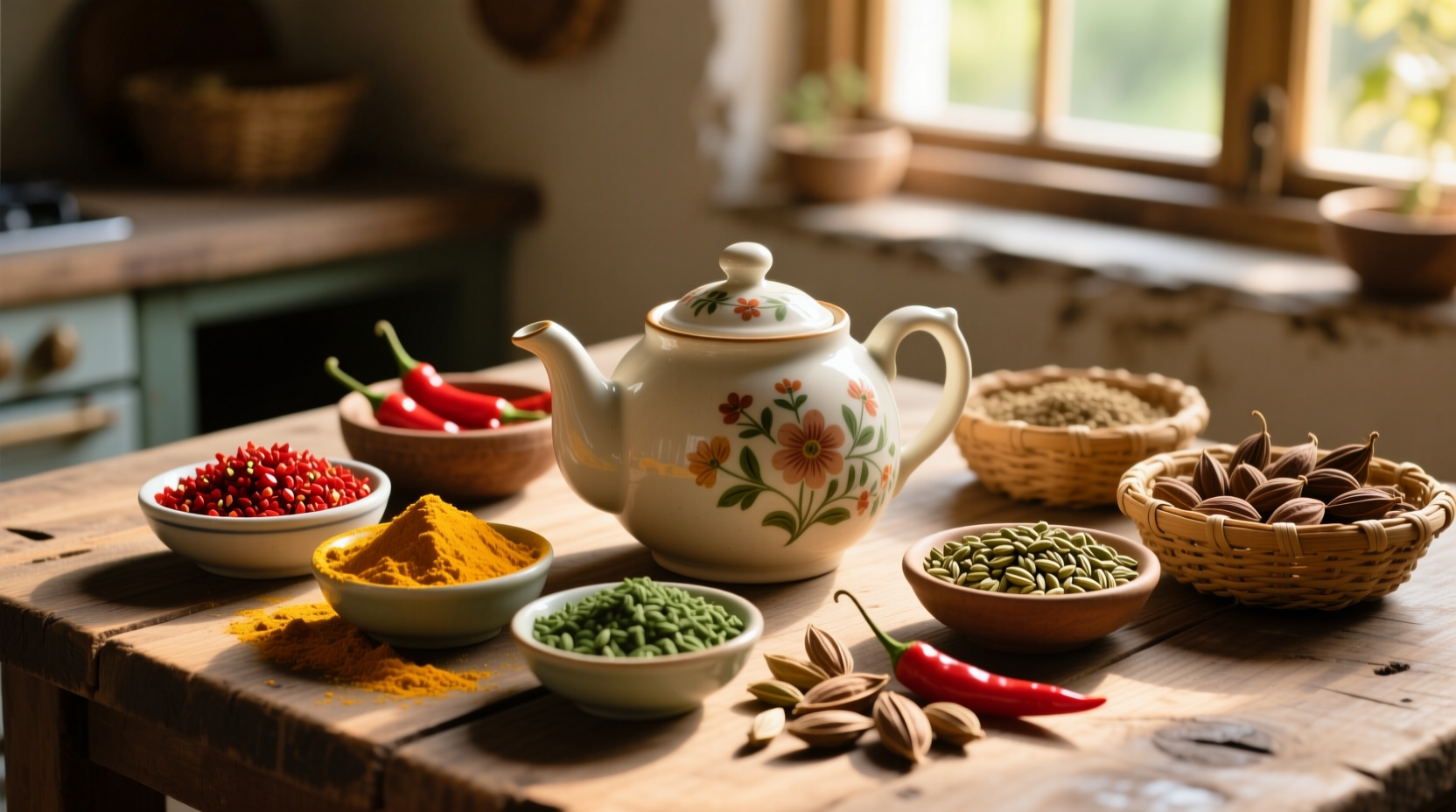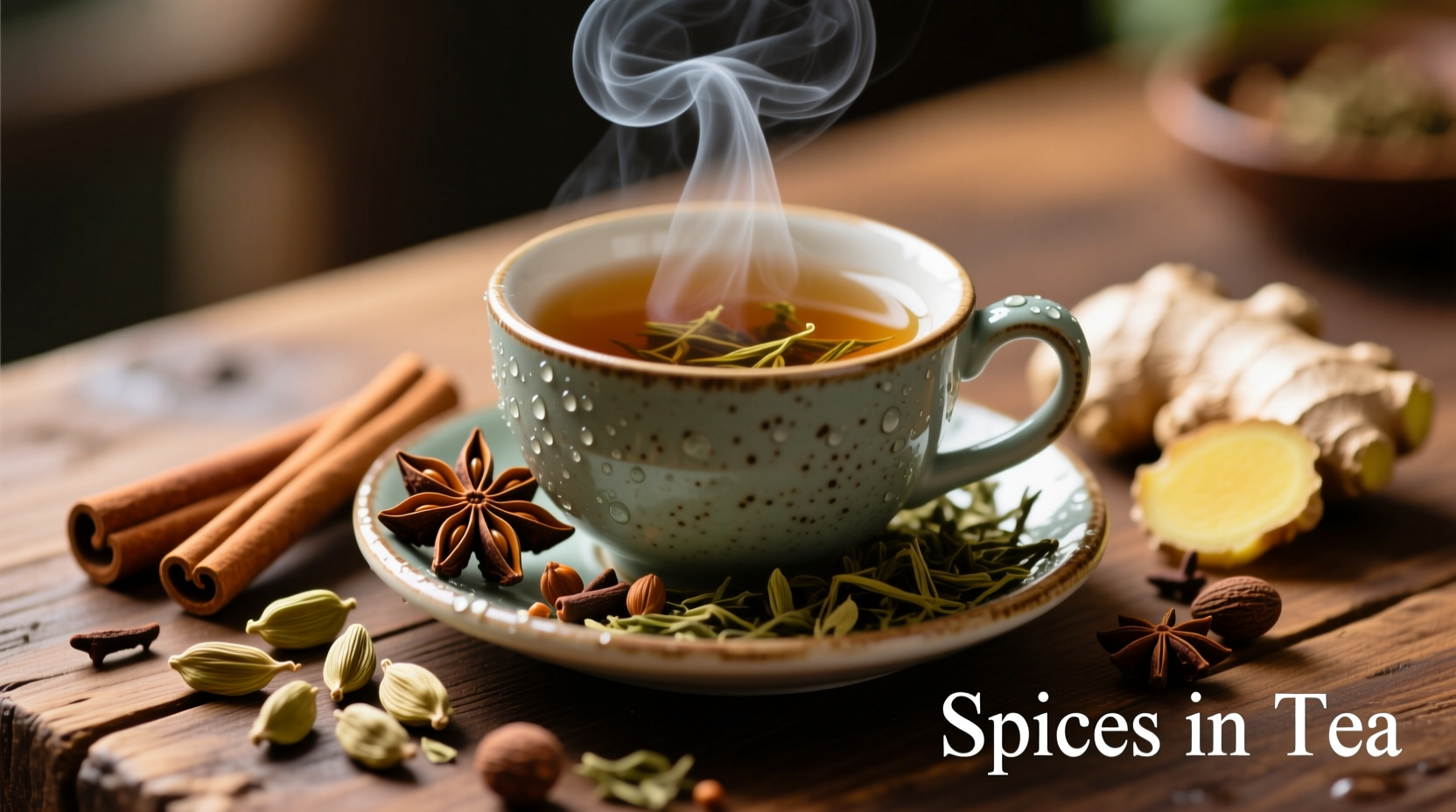Discover the perfect spice-tea pairings: Cinnamon enhances black teas with warmth, ginger adds zesty depth to green teas, and cardamom creates aromatic complexity in chai blends. These three versatile spices form the foundation of most spiced tea traditions worldwide, offering both flavor enhancement and potential wellness benefits when properly balanced with your tea base.
The Art of Spice-Tea Pairing: Beyond Basic Chai
Spices transform ordinary tea into a multi-dimensional sensory experience, but achieving balance requires understanding how different spices interact with various tea bases. Unlike pre-blended commercial options, crafting your own spiced teas lets you control flavor intensity, create personalized wellness blends, and connect with centuries of global tea traditions.
| Spice | Best Tea Pairings | Flavor Contribution | Starting Ratio |
|---|---|---|---|
| Cinnamon | Black, rooibos, pu-erh | Warm sweetness, woody notes | 1" stick per 8oz |
| Ginger | Green, white, black | Spicy brightness, clean heat | 3-5 thin slices per 8oz |
| Cardamom | Black, oolong, masala chai | Floral citrus, herbal complexity | 2-3 pods per 8oz |
| Cloves | Black, chai blends | Intense warmth, slight bitterness | 1-2 whole per 8oz |
Why Spice Selection Matters for Tea Quality
Tea's delicate flavor compounds interact differently with various spices. Black teas with robust tannins stand up to strong spices like cloves and star anise, while green teas' subtle grassy notes pair better with lighter spices such as lemongrass or mint. The University of California's Food Science Department confirms that water temperature significantly affects spice extraction—hard spices like cinnamon require boiling water and longer steeping, while delicate spices like saffron need lower temperatures to preserve volatile compounds.
Mastering the Spice-Tea Timeline
Spiced tea traditions evolved along ancient trade routes:
- 200 BCE: Chinese medicinal texts document ginger and licorice in tea preparations
- 7th century: Indian Ayurvedic traditions develop masala chai with cardamom, cloves, and black pepper
- 16th century: Portuguese traders introduce cinnamon to European tea culture
- 19th century: British colonial influence spreads spiced tea blends globally
- Today: Modern molecular gastronomy reveals why certain spice-tea combinations work scientifically
This historical progression shows how spice selection wasn't random—it developed through generations of culinary experimentation to enhance both flavor and functional benefits.
Practical Spice Application Techniques
Professional chefs use specific methods to maximize spice impact in tea:
Whole vs. Ground Spices
Always use whole spices when possible—they retain essential oils 3x longer than pre-ground versions. Crush cardamom pods just before brewing to release maximum flavor. For cinnamon, whole sticks provide more nuanced flavor than powder, which can become bitter.
Timing is Everything
Add hard spices (cinnamon, cloves, star anise) at the beginning of brewing. Introduce medium-density spices (ginger, nutmeg) midway through. Delicate spices (saffron, dried citrus peel) should go in during the last minute. This staggered approach prevents overpowering flavors while ensuring complete extraction.
The 3:2:1 Blending Principle
Start with this professional ratio for balanced blends:
- 3 parts base spice (cinnamon or cardamom)
- 2 parts complementary spice (ginger or cloves)
- 1 part accent spice (vanilla, rose, or citrus peel)
This method creates layered complexity without any single spice dominating. Adjust ratios based on your tea base—use less base spice with robust black teas, more with delicate white teas.

Avoiding Common Spice-Tea Mistakes
Even experienced tea drinkers encounter these issues:
When Spices Overpower Your Tea
If your spiced tea tastes more like medicine than beverage, you've likely used too much spice or steeped too long. Fix this by:
- Reducing spice quantity by 25% for your next batch
- Shortening steep time by 1-2 minutes
- Adding a small amount of honey or citrus to balance flavors
Dealing with Bitterness
Over-extracted spices create unpleasant bitterness. Prevent this by:
- Using filtered water (minerals intensify bitterness)
- Keeping water temperature below 200°F for delicate spices
- Removing spices after recommended steeping time
Specialized Applications for Different Needs
Match spice combinations to specific occasions:
Morning Energy Blends
Combine black tea with ginger (½ tsp), cinnamon (¼ tsp), and a pinch of black pepper. The pepper enhances curcumin absorption if adding turmeric, while ginger provides natural alertness without caffeine's crash.
Evening Relaxation Teas
For calming evening blends, pair chamomile or rooibos with cardamom (2 pods), orange peel (1 tsp), and a single clove. According to research published in the Journal of Ethnopharmacology, this combination supports relaxation through multiple pathways without sedative effects.
Preserving Spice Freshness for Optimal Flavor
Spices lose potency quickly when exposed to air, light, and moisture. Store whole spices in airtight containers away from heat sources. Properly stored, whole spices maintain peak flavor for 1-2 years, while ground spices last only 6-8 months. Test spice freshness by rubbing a small amount between your fingers—if the aroma is weak, it's time to replace your stock.
Exploring Regional Spice Traditions
Each culture developed unique spice-tea traditions based on local ingredients and climate needs:
- Moroccan Maghrebi: Gunpowder green tea with fresh mint and generous sugar
- Indian Masala Chai: Black tea with ginger, cardamom, cloves, black pepper, and milk
- Mexican Spiced Tea: Cinnamon sticks with orange peel in black tea, often sweetened with piloncillo
- Chinese Five-Spice Tea: Subtle use of star anise, cloves, Chinese cinnamon, Sichuan pepper, and fennel
These traditions evolved not just for flavor, but to address specific environmental and health considerations of each region—a testament to how spice selection serves practical purposes beyond mere taste.











 浙公网安备
33010002000092号
浙公网安备
33010002000092号 浙B2-20120091-4
浙B2-20120091-4